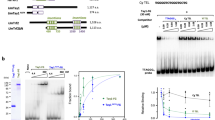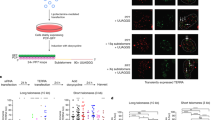Abstract
DNA termini from Tetrahymena and Oxytricha, which bear C4A2 and C4A2 repeats respectively, can support telomere formation in Saccharomyces cerevisiae by serving as substrates for the addition of yeast telomeric C1-3A repeats. Previously, we showed that linear plasmids with 108 base pairs of C4A4DNA (YLp108CA) efficiently acquired telomeres, whereas plasmids containing 28,64 base pairs of C4A4 DNA also promoted telomere formation, but with reduced efficiency1. Although many of the C4A4 termini on these plasmids underwent recombination with a C4A2 terminus, the mechanism of telomere-telomere recombination was not established1,3. We now report the sequence of the C4A4 ends from the linear plasmids. The results provide strong evidence for a novel recombination process involving a gene conversion event that requires little homology, occurs at or near the boundary of telomeric and non-telomeric DNA, and resembles the recombination process involved in bacteriophage T4 DNA replication.
This is a preview of subscription content, access via your institution
Access options
Subscribe to this journal
Receive 51 print issues and online access
$199.00 per year
only $3.90 per issue
Buy this article
- Purchase on Springer Link
- Instant access to full article PDF
Prices may be subject to local taxes which are calculated during checkout
Similar content being viewed by others
References
1. Pluta A & Zakian V Nature 337, 429-433 (1989) 2. Walmsley R Chan C Tye B K & Petes T Nature 310,157-160 (1984) 3. Szostak J W Nature 337, 303 304 (1989) 4. Murray A Claus T & Szostak J Molec cell Biol 8, 4642-4650 (1988) 5. Ahn B Y Dornfeld K J Fagrelius T J & Livingston D M Molec cell Biol 8,2442-2448 (1988) 6. Pluta A Dam G Spear B & Zakian V Proc natn Acad Sei USA 81,1475-1479(1984) 7. Bianchi M E & Radding C M Cell 35, 511-520 (1983) 8. Brr D Michel B & Ehrlich S D Cell 52, 883-892 (1988) 9. Greider C W & Blackburn E H Cell 43, 405-413 (1985) 10. Zahler A M & Prescott D M Nucleic Acids Res 16, 6953-6972 (1988) 11. Shippen Lentz D & Blackburn E H Molec cell Biol 9, 2761-2764 (1989) 12. Morm G Cell 59, 521-529 (1989) 13. Sen D & Gilbert W Nature 334, 364-366 (1988) 14. Williamson J R Raghuraman M K & Cech T R Cell 59, 871-880 (1989) 15. Henderson E Hardm C C Walk S K Tinoco I Jr & Blackburn E H Cell 51, 899-908 (1987) 16. Lyamichev V l ei al Nature 339, 634-637 (1989) 17. Henderson E et al in Eukaryotic DNA Replication Vol 6 (eds Stillman B & Kelley T ) 453 461 (Cold Spring Harbor Laboratory New York 1988) 18. Budarf M & Blackburn E Nucleic Acids Res 15, 6273 6292 (1987) 19. Zakian V A A Rev Genet 23, 579-604 (1989) 20. Mosig G A Rev Genet 21, 347-371 (1987) 21. Dunn B Szauter P Pardue M L & Szostak J W Cell 39, 191 201 (1984) 22. Maxam A M & Gilbert W Meth Enzym 65, 499-560 (1980) 23. Blackburn E H & Gall J J motee Biol 120, 33-53 (1978) 24. Henderson E R & Blackburn E H Molec cell Biol 9, 345-348 (1989) 25. Hemkoff S & Eghtedarzadeh M K Genetics 117, 711-725 (1985)
Author information
Authors and Affiliations
Rights and permissions
About this article
Cite this article
Wang, SS., Zakian, V. Telomere telomere recombination provides an express pathway for telomere acquisition. Nature 345, 456–458 (1990). https://doi.org/10.1038/345456a0
Received:
Accepted:
Issue Date:
DOI: https://doi.org/10.1038/345456a0
This article is cited by
-
How homologous recombination maintains telomere integrity
Chromosoma (2015)
-
Telomere lengthening early in development
Nature Cell Biology (2007)
-
Telomerase inhibition by peptide nucleic acids reverses `immortality' of transformed human cells
Oncogene (1999)
-
Recombination and its roles in DNA repair, cellular immortalization and cancer
AGE (1999)
-
Telomere sequence localization and karyotype evolution in higher plants
Plant Systematics and Evolution (1995)
Comments
By submitting a comment you agree to abide by our Terms and Community Guidelines. If you find something abusive or that does not comply with our terms or guidelines please flag it as inappropriate.



